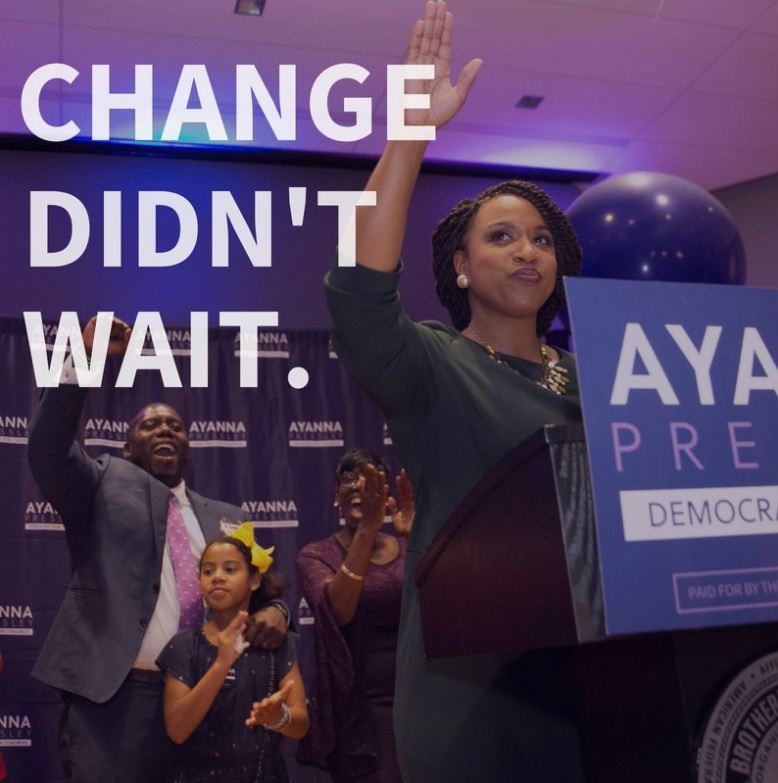News
Democratic Party transforming as it searches for leaders

Ayanna Pressley and New York’s Alexandria Ocasio-Cortez, two women of colour, both defeated Democratic incumbent congressmen in their primaries. (File Photo: Ayanna Pressley/Twitter)
BOSTON — When Ayanna Pressley topped a 10-term congressman in a Massachusetts district once represented by John Fitzgerald Kennedy, she became the latest face of a burgeoning movement of the grassroots left. “This is a fight for the soul of our party and the future of our democracy,” Pressley said. That movement is reshaping a Democratic Party still searching for leaders and identity in the era of Donald Trump.
WHAT’S HAPPENING
Grassroots activists on the left have a mixed record in Democratic primaries this election year, but the self-described progressive movement has scored enough victories to suggest its popularity is based on more than just protesting the Trump White House. The movement is also remoulding the Democratic Party into a younger, more diverse and decidedly liberal party.
Ayanna Pressley and New York’s Alexandria Ocasio-Cortez, two women of colour, both defeated Democratic incumbent congressmen in their primaries. The progressive movement has helped nominate three black Democrats for governor’s seats, including a clear upset in Florida, where Tallahassee Mayor Andrew Gillum knocked off establishment favourite Gwen Graham. Graham’s establishment credentials could not have been stronger. Her father, Bob, is a Florida icon who served as governor and U.S. senator.
———
EDITOR’S NOTE: Associated Press reporters are on the ground around the country, covering political issues, people and races from places they live. The Ground Game series highlights that reporting, looking at politics from the ground up. Each week, in stories and a new podcast, AP reporters examine the political trends that will drive the national conversation tomorrow.
———
Georgia’s Stacey Abrams, meanwhile, trounced a primary opponent recruited and backed by much of her state’s Democratic old guard. Abrams would become the first black woman elected governor in any U.S. state.
Scores of other down-ballot candidates are running for local, state and federal offices with backing from grassroots groups like Indivisible, MoveOn.org, the Working Families Party and the offshoot of Bernie Sanders’ 2016 presidential campaign, Our Revolution.
——
WHY IT MATTERS
The diversifying, more liberal slate will be measured by the outcome in the November vote.
Republicans — and some Democrats — argue that the party is going too far to the left for American voters, particularly outside of the cities and close-in suburbs where Democrats’ base of white liberals and non-white voters is concentrated.
Progressive nominees like Pressley and Ocasio-Cortez are running in Democratic strongholds, so their wins in November are all but guaranteed. But Republicans will use the rise of the left — and its support for policies like single-payer health care and scrapping U.S. Immigration and Customs Enforcement — to tar all Democratic candidates.
The counter argument from Democrats and activists on the left is two-fold: 1) Many issues that more liberal candidates support — some gun regulation, expanding Medicaid, raising the minimum wage — actually have widespread public support, even among independents and some Republicans; and 2) the more openly liberal candidates from outside the old-guard establishment can bring in new voters who don’t regularly cast midterm ballots.
Beyond November, the new generation of Democrats will have a say in how the party governs. Pressley and Ocasio-Cortez won’t determine whether Democrats pick up the 23 new House seats they need for a majority, but they’ll help shape the arguments within the Democratic caucus.
They and their fellow freshmen will have a say in whether a new Democratic majority returns Nancy Pelosi to the speaker’s chair. They’ll have leverage — much like the arch-conservative Freedom Caucus does with the House GOP leadership — over every debate, from health care to the potential impeachment of Trump.
So, for example, while there might not be enough support for a real push toward single-payer health care, the movement could draw the party toward supporting a public health insurance option to compete alongside for-profit companies selling policies in Affordable Care Act exchanges. And, even if an immediate $15 minimum wage is too heavy a lift, perhaps the left-flank forces a compromise of graduated raises over time.
——
WHAT TO WATCH
Before primary season concludes, there are a few more key matchups to measure the left’s influence. In Delaware, military veteran and activist Kerri Evelyn Harris is aiming Thursday to knock off moderate Democratic Sen. Tom Carper. She’s a big underdog, but even a competitive finish will serve notice anew that incumbents must at least contend with the left base. Similar dynamics exist in New York, where actress Cynthia Nixon is trying to topple Gov. Andrew Cuomo in a Sept. 13 primary.
——
DON’T MISS
Some of the most intent observers of party’s evolution are the gaggle of aspiring presidential candidates. Certainly, some of those figures have helped drive the shift — Sanders and his 2016 campaign, Massachusetts Sen. Elizabeth Warren and her outspoken economic populism.
But Sanders, Warren and rest also are careful to watch the base and not get caught flat-footed as it evolves. That’s one reason potential candidates like Sens. Cory Booker and Kamala Harris and former Vice-President Joe Biden have made sure that their endorsement and campaign finance activity this midterm cycle has spanned the spectrum of the party’s down-ballot candidates: If the so-called progressive movement becomes the centre of the party, no one who wants to be the Democratic presidential nominee wants to be boxed out.





















